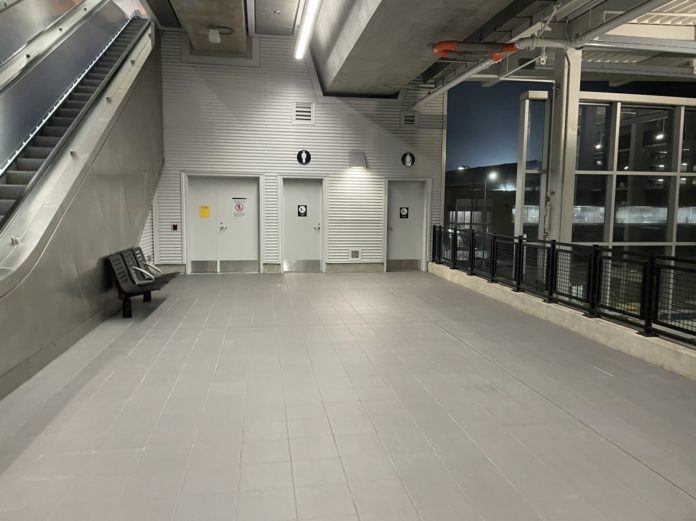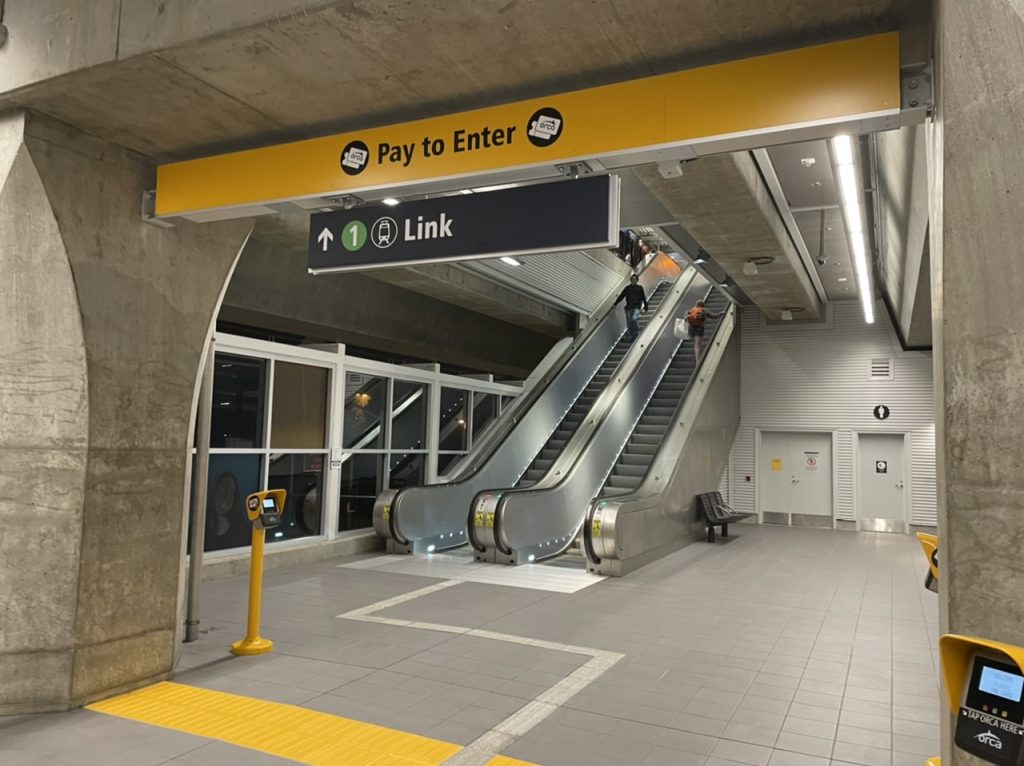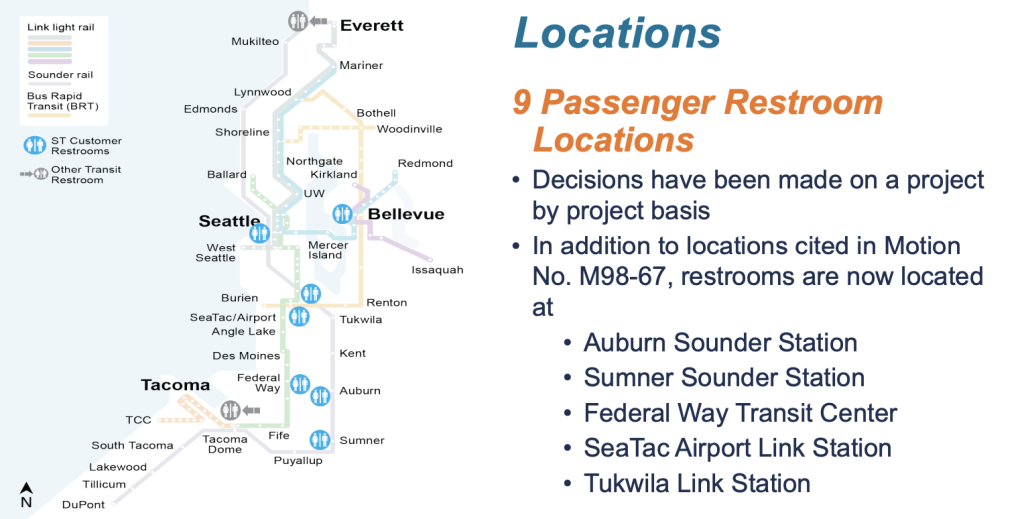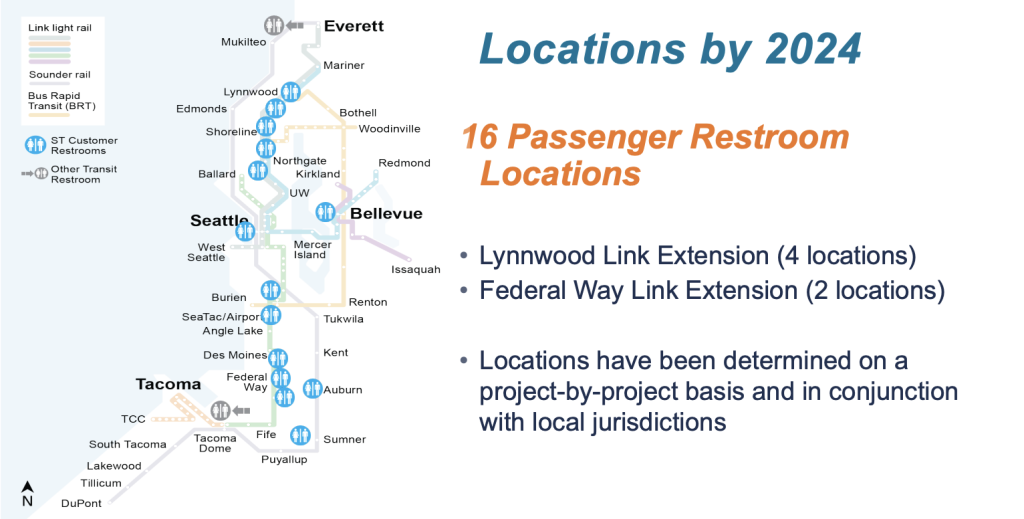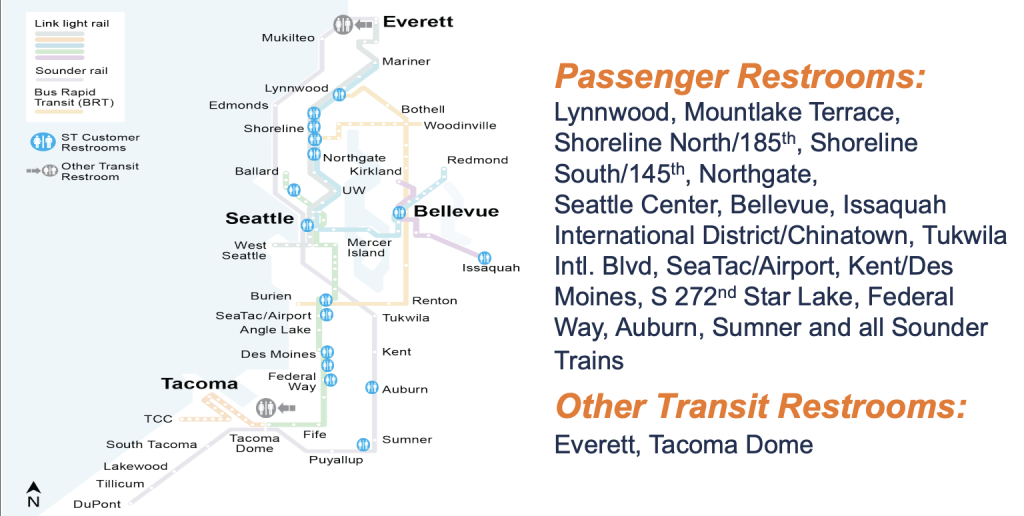More passenger restrooms are ahead in Sound Transit’s ever-growing system. However, a recommended policy update would discourage them from becoming a universal and easily accessible feature at light rail stations because of stringent criteria.
Under the policy, 16 transit facilities throughout Sound Transit’s network could have passenger restrooms by 2024. Only an additional two stations would benefit from passenger restrooms in the following two decades, leaving wide swaths of the light rail system without any facilities.
On Thursday, some boardmembers expressed concern with the proposed restroom policy for these very reasons.
Recommended restroom policy disregards passenger experience
Agency staff are proposing new passenger restroom policies going forward, which would severely limit the number of new restrooms at transit facilities. The policy has been justified by citing projected operational costs and cherry-picking peer North American transit agencies.
In speaking with transit agencies from the likes of Portland, Los Angeles, Toronto, and Miami, Sound Transit suggested that four key themes had come out of those discussions, which included that:
- Restrooms are for passengers only;
- Restrooms are only at major transit hubs;
- Restrooms are located within fare-paid zones; and
- Restrooms are locked, but can be used if specifically requested.
Sound Transit also cited average yearly costs per passenger restroom at $322,174 for cleaning, security, and maintenance. With nine passenger restrooms in the system today, the annual cost is $2.9 million. The recommended policy, however, would mean more locations and annual costs would rise to $4.5 million with 14 passenger restrooms and $5.2 million with 16 passenger restrooms.
The staff-recommended criteria establishes a three-prong test to determine when to provide passenger restrooms. The criteria would require a station to:
- Have an average of 10,000 or more boardings per day;
- Be at least a 20-minute ride from the nearest passenger restroom; and
- Have least five or more transit routes converging at the station.
Essentially, the recommended criteria would encourage passenger restrooms at key station locations, similar to cited peer agencies. The recommended policy would also direct passenger restrooms to be located in fare-paid zones — like at Northgate Station where two restrooms are located just beyond the fare-paid line on the mezzanine level.
This policy means that passengers would have to use fare media (e.g., ticket or activated ORCA card) to access restrooms. It also assumes that a 20-minute ride is acceptable period of time. Of course, that’s a fairly long time when someone needs to relieve oneself and it doesn’t account for the time penalty when waiting at a station, which is complicated by the fact that Sound Transit maintains exceedingly low frequencies for an urban rapid transit system (every eight to ten minutes during most hours for Link).
Conversely, in Asia and Europe, passenger restrooms are fairly common features at rapid metro and suburban rail stations. Though the implementation and policies surrounding them differ greatly. In Tokyo and Seoul, restrooms are fairly ubiquitous at stations often with no cost to passengers and available outside of fare-paid zones. In London, passenger restrooms are comparably sparse, but well-identified and free of charge, whereas in Continental Europe they tend to require payment of a fee to use.
Under the proposal, 16 passenger restrooms (inclusive of facilities operated by other transit agencies) would exist in the system by 2024, an increase of just six from the ten existing today. Future transit expansions would bring that number to 18 passenger restrooms by 2041 with completion of the Ballard and South Kirkland-Issaquah Link extensions.
The maps show huge passenger restroom deserts in Seattle, the Eastside, and south of Federal Way whereas stations on the Federal Way and Lynnwood Link extensions net many new restrooms. This raised concern by King County Councilmember Claudia Balducci who expected the recommended policy to have better geographic consideration.
“I feel like I want to do some more work on this one,” Balducci said. “When you apply these criteria, you end up with an entire section of our system that has virtually no restroom access, which I don’t think is what we were going for.” Board Chair and University Place City Councilmember Kent Keel said that Balducci was getting at some of his same concerns.
Agency staff tried to reassure boardmembers that the south end looks worse than it really is because Sounder commuter trains all have bathrooms onboard even though stations general don’t have them present. Staff also said that passengers in restroom deserts were still only a 20-minute ride or less away. Nevertheless, boardmembers said they wanted more information and work around the issue. To keep things moving forward, boardmembers passed the policy resolution out of committee without recommendation to the full board for further consideration.
Whether or not Sound Transit will seriously improve the policy proposal remains to be seen, but it’s hard to be optimistic given the fact that the agency has been under the microscope on this issue for quite some time. Coming out with recommended policies that could hardly be called anything other than draconian and a poo pooing of the passenger experience doesn’t instill confidence. If the policy isn’t seriously improved, a backstop could be local governments — on their own accord or because of passenger advocates pushing them — adopting local development standards or permitting conditions for stations to include passenger restrooms. This has already been done in some cities, so there’s no reason that it can’t be replicated if needed to achieve a better passenger experience throughout the system.
Stephen is a professional urban planner in Puget Sound with a passion for sustainable, livable, and diverse cities. He is especially interested in how policies, regulations, and programs can promote positive outcomes for communities. With stints in great cities like Bellingham and Cork, Stephen currently lives in Seattle. He primarily covers land use and transportation issues and has been with The Urbanist since 2014.


